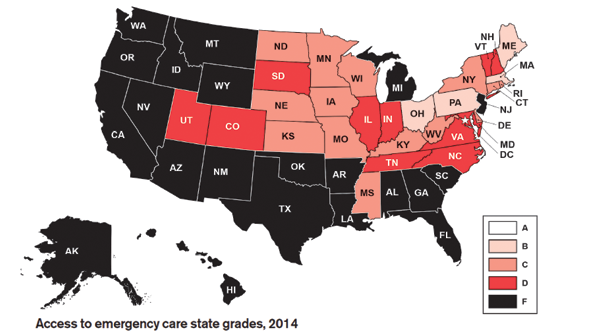
A near-failing grade for most states points to subpar conditions and policies for delivery of EM care, lack of support for hospitals, say ACEP leaders
Last month’s release of ACEP’s 2014 Report Card on Emergency Medicine was considered a wake-up call to the health-care system, revealing a lack of support for emergency patients and a deserving D+ overall grade. One category set off the fire alarm.
Explore This Issue
ACEP Now: Vol 33 – No 02 – February 2014Access to Emergency Care, which accounted for 30 percent of the overall grade and was weighted more heavily than the other four (Quality and Patient Safety, Medical Liability Environment, Public Health and Injury Prevention, and Disaster Preparedness) and showed that very few states get the support they need in terms of conditions and policies under which emergency care is being delivered. It received a grade nationwide of D-, and 22 states received an F.
Overall, this category hasn’t improved since the last time ACEP released the Report Card in 2009.
The Report Card measures conditions and policies under which emergency care is being delivered, not the quality of care provided by hospitals and emergency providers. Emergency physicians across the country, including ACEP President Alex M. Rosenau, DO, FACEP, say this category is crucial when it comes to improving the support for emergency department patients. ACEP is encouraging its members to talk with legislators and make them aware of deficiencies.
“Access is one of the most important parts of providing care to any type of patient,” Dr. Rosenau said. “If a patient can’t get in to see a physician and can’t get care, the best medicine in the world won’t mean anything.”
ACEP points out in the report that access to emergency care is both fundamental and complex. The College is urging news outlets to recognize that emergency departments are a vital part of the health care system in each community and region. They deliver emergency care day in and day out, and they serve as the health care safety net for anyone, insured or not, who cannot otherwise obtain timely health care services when needed. Access to emergency care is complex because the demand for emergency services often is related to the capacity of the broader health care system to deliver services.
Thus, measures of Access to Emergency Care must include elements that comprise that broader system. This category measures the availability of emergency care resources, such as numbers of emergency physicians, emergency departments, registered nurses, and trauma centers per person, along with proximity to Level I or II trauma centers, and the median time from arrival to departure from the emergency department. Because emergency department capacity is also a function of the broader health care system, the access category includes key measures of that system’s capacity, such as the availability of primary care, mental health care, and substance abuse treatment.
Pages: 1 2 3 | Single Page




No Responses to “ACEP’s 2014 Report Card on Emergency Medicine Reveals Major Access-to-Care Deficit”